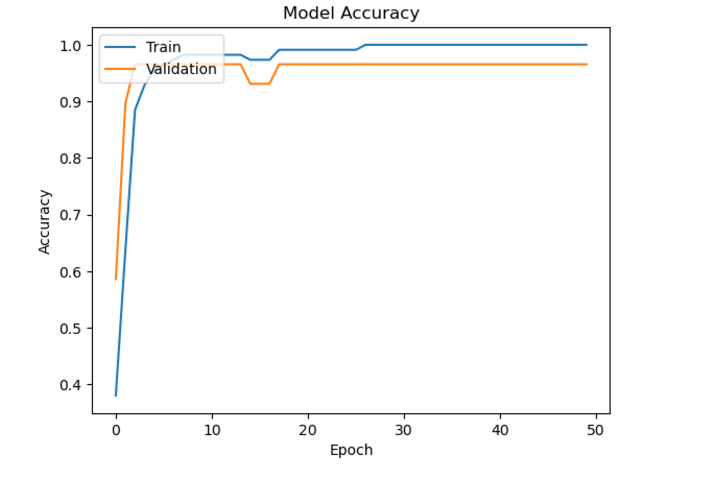Python 使用深度学习预测葡萄酒类型
近年来,由于深度学习能够分析复杂数据集并进行准确预测,它引起了广泛关注,其中一个引人注目的应用是基于各种化学属性对葡萄酒类型进行预测。通过利用深度学习算法的能力,研究人员已经能够开发出能够高精确度地对葡萄酒进行分类的模型。
本文探讨了使用深度学习技术(如神经网络)通过属性(如酒精含量、酸度和酚类化合物)预测葡萄酒类型。通过发掘深度学习的潜力,葡萄酒生产商和爱好者可以增强他们的决策过程,并提高葡萄酒质量评估,最终带来更好的顾客满意度和行业进步。
使用深度学习预测葡萄酒类型
以下是我们使用深度学习预测葡萄酒类型的步骤−
步骤1:导入所需的库
Pandas用于数据处理,NumPy用于数值操作,Matplotlib用于数据可视化,Scikit-learn用于数据预处理,Keras用于构建深度学习模型。
步骤2:加载数据集
使用Pandas的pd.read_csv()函数将数据集加载到DataFrame中。
步骤3:数据预处理
在此步骤中,将属性提取到变量X中,将目标变量(葡萄酒类型)提取到变量y中。
步骤4:编码葡萄酒类型
葡萄酒类型是分类变量,因此需要将其编码为数字值,以便模型能够理解。使用Scikit-learn的LabelEncoder()类将葡萄酒类型转换为数字标签。
步骤5:数据分析
此步骤提供有关数据集的一些基本信息。它计算数据集中的特征(属性)数量、类别(唯一葡萄酒类型)数量和样本(行)数量。然后打印这些值以进行分析。
步骤6:将数据集拆分为训练集和测试集
使用Scikit-learn的train_test_split()函数将数据集拆分为训练集和测试集。将80%的数据分配给训练集,20%分配给测试集。random_state参数确保可重现结果。
步骤7:标准化特征
特征缩放对于深度学习很重要。这里使用Scikit-learn的StandardScaler()类对特征进行标准化。训练集使用fit_transform()进行拟合和转换,而测试集只使用transform()进行转换,以避免数据泄漏。
步骤8:创建模型
此步骤涉及使用Keras框架构建深度学习模型。模型遵循顺序结构,其中各层依次排列。Dense层表示全连接层,每个神经元与前一层和后续层中的每个神经元相连。
示例
下面是使用上述步骤的程序示例。
import pandas as pdd
import numpy as npp
from tensorflow.keras.models import Sequential
from tensorflow.keras.layers import Dense
import matplotlib.pyplot as pltt
from sklearn.model_selection import train_test_split
from sklearn.preprocessing import LabelEncoder, StandardScaler
# Load the dataset
datasetd = pdd.read_csv('wine.csv')
# Data preprocessing
X = datasetd.iloc[:, 1:].values
y = datasetd.iloc[:, 0].values
# Encode the wine types
label_encoder = LabelEncoder()
y = label_encoder.fit_transform(y)
num_features = X.shape[1]
num_classes = len(np.unique(y))
num_samples = X.shape[0]
print(f"Number of samples: {num_samples}")
print(f"Number of features: {num_features}")
print(f"Number of classes: {num_classes}")
# Split the dataset into training and testing sets
X_train, X_test, y_train, y_test = train_test_split(X, y, test_size=0.2, random_state=42)
# Standardize the features
scaler = StandardScaler()
X_train = scaler.fit_transform(X_train)
X_test = scaler.transform(X_test)
# Create the model
model1 = Sequential()
model1.add(Dense(64, activation='relu', input_shape=(num_features,)))
model1.add(Dense(64, activation='relu'))
model1.add(Dense(num_classes, activation='softmax'))
model1.compile(optimizer='adam', loss='sparse_categorical_crossentropy', metrics=['accuracy'])
# Train the model
history = model1.fit(X_train, y_train, batch_size=32, epochs=50, validation_split=0.2, verbose=1)
# Plot the training history
pltt.plot(history.history['accuracy'])
pltt.plot(history.history['val_accuracy'])
pltt.title('Model Accuracy')
pltt.xlabel('Epoch')
pltt.ylabel('Accuracy')
pltt.legend(['Train', 'Validation'], loc='upper left')
pltt.show()
# Evaluate the model
loss, accuracy = model1.evaluate(X_test, y_test, verbose=0)
print(f'Test Loss: {loss:.4f}')
print(f'Test Accuracy: {accuracy:.4f}')
# Predict on new data
new_data = [[13.24, 2.59, 2.87, 21.0, 118, 2.8, 2.69, 0.39, 1.82, 4.32, 1.04, 2.93, 735]]
new_data_scaled = scaler.transform(new_data)
predictions = model1.predict(new_data_scaled)
predicted_class = npp.argmax(predictions)
# Map predicted class to wine type
predicted_wine_type = label_encoder.inverse_transform([predicted_class])[0]
print(f'Predicted Wine Type: {predicted_wine_type}')
输出
Number of samples: 178
Number of features: 13
Number of classes: 3
Epoch 1/50
4/4 [==============================] - 1s 81ms/step - loss: 1.0252 - accuracy: 0.3805 - val_loss: 0.8866 - val_accuracy: 0.5862
……………………………………………………………………………………………………………………………………………..
Epoch 50/50
4/4 [==============================] - 0s 12ms/step - loss: 0.0109 - accuracy: 1.0000 - val_loss: 0.0520 - val_accuracy: 0.9655

Test Loss: 0.0074
Test Accuracy: 1.0000
1/1 [==============================] - 0s 88ms/step
Predicted Wine Type: 1
结论
总的来说,使用深度学习来预测葡萄酒类型显示出巨大的潜力。通过利用大量关于葡萄酒属性的数据,深度学习算法已经成功地根据化学成分精确地对葡萄酒进行分类。这一进步有望在葡萄酒行业引发重大变革。
它使生产商能够在葡萄栽培、发酵技术和风味特点方面做出明智的选择。最终,这项技术将推动葡萄酒生产的革命,并改进生产商的决策过程,提高质量,为葡萄酒爱好者提供更加满意的体验。
 极客笔记
极客笔记